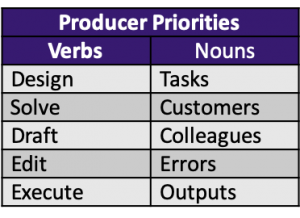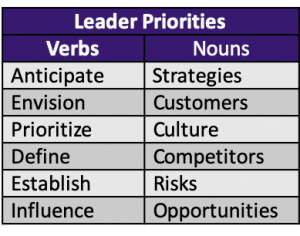In 2007, when Vince Molinaro, David Weiss and I were writing Leadership Solutions, we got the feedback that our manuscript needed to include a definition of leadership. At the time, I resisted that advice. Isn’t the definition of leadership obvious?
Silly me.
Twelve years later, I find myself talking frequently about the difference between management and leadership because so many supposed leaders are spending significant time managing and scant time leading. Some are even so far in the weeds that they’re just producing, not even managing. That’s a dangerous path.
How do you rate yourself on getting the mix right?
Let’s start with some quick definitions so you and I are on the same page.
Definitions
Producing
The standard way of talking about the leadership progression is “do-manage-lead.” I want to replace the term “do” because you’re doing something when you’re managing or leading, so that term doesn’t help to clarify what’s unique about the three different ways of adding value.
Instead, I’m going to use “producing” to signify that this is time spent creating a work product. If you work in hospitality and you have to jump in at the omelet bar, that’s producing. If you work in high tech and you’re debugging code, that’s producing.
If you’ve worked with us on a team effectiveness process, you’ll know that Craig and I use lists of verbs and nouns to focus people’s attention on the topics (nouns) and the activities (verbs) they should prioritize. Here are a few high priority verbs and nouns for producing:

Managing
Managing is orchestrating production. It’s the time you spend figuring out how the organization is going to accomplish what you need to. Managing is about optimizing the status quo. Can you allocate resources more efficiently? Is there a way to get more output from fixed resources? A few high priority management verbs and nouns for managing are:

Leading
Leading is setting the course. It’s the time you spend figuring out what to pay attention to and which questions to ask. Leading is about setting the pace and trajectory for the organization. Are you playing in the right spaces? How will you win where you chose to play? What’s next? A few high priority verbs and nouns for leading are:

So, how are you doing?
How much of your day is filled with producing and managing? Are you paying attention to leading?
Why Does it Matter
It’s important that you are aware of the distinction between managing and leading because, if you’re not diligent, the drive to optimize your current business will suck you into managing (and producing) and away from leading. At some point when you’ve been producing and managing but not leading, you’ll lift your eyes to the horizon and find you’re about to careen off a cliff.
Spend More Time Leading
Here are a few opportunities to add more leadership to your days, weeks, months, and years.
- To each day, add time to listen and sense. Make time with key stakeholders where you focus on asking questions and gaining new insights. These stakeholders might be employees, customers, vendors, experts, analysts, or board members. The point is that you’re off of transmit and onto receive.
- To each week, add time to read, think, reflect, and explore. Schedule at least two hours in your week where you will take in information from outside your organization and one hour to let those ideas bounce around in your head and come out in note form. That hour of reflection should be in silence. It’s ok if it’s on your commute (I love airplanes for this) but it’s cheating if you’re listening to the radio or a podcast.
- To each month, add time to build the capability and capacity of your business. Spend at least four hours (preferably a full-day) a month leading your team through a process to identify and analyze issues and opportunities and to scope and delegate projects to capitalize on strengths and to mitigate weaknesses.
- To each year, add time to change the nature of your business. Spend at least three full-day sessions figuring out what new questions you need to be asking and answering. Draw in expertise and insight from outside the organization to shake things up. Dare, dream, imagine.
And Everywhere Else
The good news is that you can also use time spent producing and managing to gain insights into your leadership responsibilities if you’re always looking through a leadership lens.
- A conversation with a customer becomes an opportunity to learn about an unmet need that could be a future product offering;
- A coaching meeting with a direct report provides the chance to learn about the culture or to identify emerging skill requirements; and
- An urgent crisis creates new clarity about a flaw in your systems.
Even if your calendar is back-to-back with meetings, you can’t abdicate your responsibility to lead.
One More Thought: What’s in a Name?
The delineation between management and leadership also shows up at the team level. If you’re part of a team whose responsibility is to steer some or all of the organization, what is your team called? Are you the “Leadership Team,” or the “Management Team,” or the “Executive Team?” Does your name reflect your mandate? Do your agenda match both your name and your obligations? If not, take some time to consider a new meeting structure.
There’s a big difference between the value you add when you’re producing, managing, and leading. It’s too easy to neglect your leadership responsibilities when you’re overwhelmed by the doing and managing of daily business. Resolve to put more leadership into your day, your week, your month, and your year. It will be time well spent.
Further Reading
Delegation is a flawed concept
In defence of senior management
